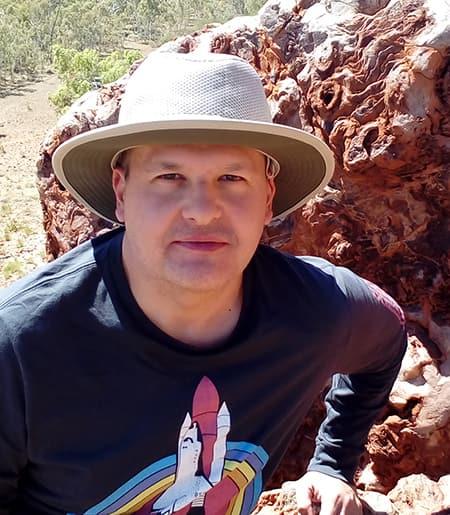Overview
Alberto Fairén is an interdisciplinary planetary scientist and astrobiologist, specializing in geochemistry, mineralogy, hydrogeology, sedimentology and environmental microbiology of extremophiles, with a particular focus on understanding the habitability of early Mars and the search for life on Mars and ocean worlds. His work has been achieved through multi-disciplinary collaboration with researchers from around the world, and is published in >160 papers and >300 communications at international conferences. See Alberto's work featured in the Cornell Chronicle, in Research Outreach, in the EU Research magazine, and in the Horizon EU magazine.
Involvement in missions to Mars
- NASA: MER-B Opportunity, Athena Science Team Member (2012-2014).
- NASA: MSL Curiosity, Science Team Member on SAM (2012-2014), APXS (2012-2014) and REMS (2014-present).
- NASA: Mars2020, Science Team Member on MEDA (2021-2025).
- ESA: ExoMars, Member of the Rover Science Operations Working Group (RSOWG), Science Team Member on PanCam, CLUPI and RLS, and Member of the Landing Site Selection Working Group (LSSWG).
Awards and Honors
- 2021 EANA Outstanding Paper Award.
- 2019-2024 PI of the ERC Consolidator Grant MarsFirstWater.
- 2014-2019 PI of the ERC Starting Grant icyMARS.
- 2012 recipient of the AAS-DPS Urey Prize.
Publications
- Fairén (2025). Human space travel risks contaminating Mars. Nature, 643, 35.
- Cañadas, et al., and Fairén (2025). Archaean oxygen oases driven by pulses of enhanced phosphorus recycling in the ocean. Nature Geoscience, 18, 430-435.
- Viúdez-Moreiras et al., including Fairén (2025). Ultraviolet and biological effective dose observations at Gale Crater, Mars. PNAS, 122 (21) e2426611122.
- Hurowitz et al., including Fairén (2025). Redox-driven mineral and organic associations in Jezero Crater, Mars. Nature, 645, 332–340.
- Kizovski et al., including Fairén (2025). Fe-phosphates in Jezero Crater as evidence for an ancient habitable environment on Mars. Nature Communications, 16, 6470.
- Holcomb et al., including Fairén (2024). The emerging archaeological record of Mars. Nature Astronomy, 8, 1490–1492.
- Fairén & Cabrol (2023). A new deal for the human exploration of Mars. Nature Astronomy, 7, 753–754.
- Fairén et al. (2023). Ecological successions throughout the desiccation of Tirez lagoon (Spain) as an astrobiological time-analog for wet-to-dry transitions on Mars. Scientific Reports, 13, 1423.
- Hader, Fairén, MacLeod (2023). Planetary Protection requirements should address pollution from chemicals and materials. PNAS, 120 (42) e2310792120.
- Azua-Bustos, Fairén, et al. (2023). Dark microbiome and extremely low organics in Atacama fossil delta unveil Mars life detection limits. Nature Communications, 14, 808.
- Farley et al., including Fairén (2022). Aqueously altered igneous rocks sampled on the floor of Jezero crater, Mars. Science, 377, eabo2196 .
- Liu et al., including Fairén (2022). An olivine cumulate outcrop on the floor of Jezero crater, Mars. Science, 377, 1513–1519.
- Scheller et al., including Fairén (2022). Aqueous alteration processes in Jezero crater, Mars − implications for organic geochemistry. Science, 10.1126/science.abo5204.
- Hamran et al., including Fairén (2022). Ground penetrating radar observations of subsurface structures in the floor of Jezero crater, Mars. Science Advances, 8, 34, 8564 .
- Bell et al., including Fairén (2022). Geological, multispectral, and meteorological imaging results from the Mars 2020 Perseverance rover in Jezero crater. Science Advances, 8, 47, 4856.
- Tice et al., including Fairén (2022). Alteration history of Séítah formation rocks inferred by PIXL x-ray fluorescence, x-ray diffraction, and multispectral imaging on Mars. Science Advances, 8, 47, 9084.
- Losa-Adams, Gil-Lozano, Fairén, et al. (2021). Long lasting habitable periods in Gale crater constrained by glauconitic clays. Nature Astronomy, 5, 936-942.
- Titus et al., including Fairén (2021). A roadmap for planetary caves science and exploration. Nature Astronomy, 5, 524-525.
- Fairén (2020). Organic chemistry on a cool and wet young Mars. Nature Astronomy, 4, 446-447.
- Wierzchos, et al., and Fairén (2020). Crystalline water in gypsum is unavailable for cyanobacteria in laboratory experiments and in natural desert endolithic habitats. PNAS, 117, 27786-27787.
- Bishop, Fairén, et al. (2018). Surface clay formation during short-term warmer and wetter conditions on a largely cold ancient Mars. Nature Astronomy, 2, 206-213.
- Fairén (2017). Icy Mars lakes warmed by methane. Nature Geoscience, 10, 717-718.
- Hurowitz et al., including Fairén (2017). Redox stratification of an ancient lake in Gale crater, Mars. Science, 356, eaah6849.
- Bristow et al., including Fairén (2017). Low Hesperian pCO2 constrained from in situ mineralogical analysis at Gale crater, Mars. PNAS, 114, 2166-2170.
- Stern et al., including Fairén (2015). Evidence for indigenous nitrogen in sedimentary and aeolian deposits from the Curiosity rover investigations at Gale crater, Mars. PNAS, 112, 4245-4250.
- Fairén (2014). The Mars rovers 200 years from now. Science, 343, 24.
- Arvidson et al., including Fairén (2014). Ancient aqueous environments at Endeavour Crater, Mars. Science, 343, 387.
- Ming et al., including Fairén (2014). Volatile and organic compositions of sedimentary rocks in Yellowknife Bay, Gale Crater, Mars. Science, 343, 388.
- Fairén & Schulze-Makuch (2013). The overprotection of Mars. Nature Geoscience, 6, 510-511.
- Fairén et al. (2011). Cold glacial oceans would have inhibited phyllosilicate sedimentation on early Mars. Nature Geoscience, 4, 667-670.
- Fairén et al. (2010). Noachian and more recent phyllosilicates in impact craters on Mars. PNAS, 107, 12095-12100.
- Fairén (2010). Refilling the oceans of early Mars. Nature Geoscience, 3, 452-453.
- Fairén et al. (2009). Stability against freezing of aqueous solutions on early Mars. Nature, 459 (7245), 401-404.
- Fairén (2008). Finding of unusual soil on Mars could stem from tools used. Nature, 456, 870.
- Fairén (2005). What should we call Pluto? Science, 310, 53-54.
- Fairén et al. (2004). Inhibition of carbonate synthesis in acidic oceans on early Mars. Nature, 431, 423-426.
POPULAR SCIENCE:
Alberto has published 3 books and over 275 articles of popular science (Planetology, Astrobiology and Molecular Biology) in newspapers and magazines in Spain and South America (in Spanish).
2023 Madri+d Science in Spanish Prize: Best popular science article 2018-2022.

